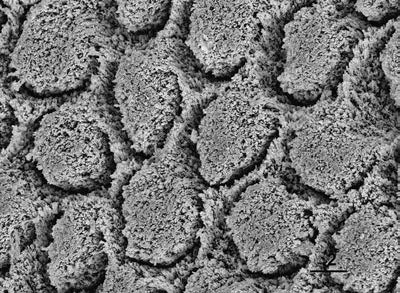In dentistry, bonding of resin-based materials to tooth structure is a result of four possible mechanisms, as follows: (ref. 3)
- Mechanical
- Adsorption
- Diffusion
- Combination of above three
For good adhesion, close contact must exist between the adhesive and the substrate (enamel or dentin). The surface tension of the adhesive must be lower than the surface energy of the substrate.
ENAMEL
Acid-etching transforms the smooth enamel into an irregular surface and increases its surface free energy. When a fluid resin-based material is applied to the irregular etched surface, the resin penetrates into the surface, aided by capillary action. Monomers in the material polymerize, and the material becomes interlocked with the enamel surface. (ref 4,5) The formation of resin microtags within the enamel surface is the fundamental mechanism of resin-enamel adhesion. (ref. 6,7)
 |
| Scanning electron micrograph (SEM) of enamel etched with 35 % phosphoric acid for 15 seconds |
DENTIN
Adhesive materials can interact with dentin in different ways—mechanically, chemically, or both. The importance of micromechanical bonding, similar to what occurs in enamel bonding, has become accepted. (ref. 8) Dentin adhesion relies primarily on the penetration of adhesive monomers into the network of collagen fibers left exposed by acid etching. (ref. 9,10) However, for adhesive materials that do not require etching, such as glass ionomer cements and some phosphate-based self-etch adhesives, chemical bonding between polycarboxylic or phosphate monomers and hydroxyapatite has been shown to be an important part of the bonding mechanism. (ref. 11)
| Higher magnification view of dentin etched with 35 % phosphoric acid, col- collagen exposed by the acid, D- normal dentin, T - dentinal tubule, S- residual silica particles used as acid gel thickener |
Cementum is the first target for plaque bacteria attack in the process of root caries formation, and is still thought to be the most unpredictable area of an adhesive resin restoration. Cementum hybridization is related to structure, chemical composition and bonding efficacy of human cementum, which has a lower packing density than dentin. Cementum is a specialized and mineralized tissue (20–200 micrometers thick), pale yellow with dull surface. The principal inorganic component is hydroxyapatite while other forms of calcium are also present. It is considered to be rich in organic phase (about 50%) of collagen fibers and other matrix proteins. The ultrastructure of etched cementum surfaces was of a more spongy appearance with a large collagen fiber network compared with that of dentin, displaying longer and more deeply voluminous array of tufted fibrils. It is less hard and more permeable to a variety of materials compared with enamel and dentin.
Cementum in the cervical area is an acellular extrinsic fiber cementum. This substratum is a nonuniform, and relatively rough tissue. Human cementum can be represented as a woven fabric-like material that provides tissue porosity and permeability. One of the surface features that distinguish demineralized cementum from dentin is a lack of patent tubule orifices. With an absence of these openings, cementum is at a distinct disadvantage when it comes to enhanced bonding adhesion.
 |
| AFM (Atomic force microscopy) images of 50 micrometer * 50 micrometer area of 35% H3PO4 etched cementum |
References:
1. Sturdevant's Art and Science of Operative Dentistry, 6th Edition
2. Packham DE: Adhesion. In Packham DE, editor: Handbook of adhesion, Essex, UK, 1992, Longman Scientific & Technical, pp 18–20.
3. Söderholm K-JM: Correlation of in vivo and in vitro performance of adhesive restorative materials: A report of the ASC MD156 Task Group on test methods for the adhesion of restorative materials. Dent Mater 7:74–83, 1991.
4. Asmussen E, Munksgaard EC: Bonding of restorative materials to dentine: Status of dentine adhesives and impact on cavity design and filling techniques. Int Dent J 38:97–104, 1988.
5. Buonocore MG, Matsui A, Gwinnett AJ, et al: Penetration of resin into enamel surfaces with reference to bonding. Arch Oral Biol 13:61–70, 1968.
6. Barkmeier WW, Shaffer SE, Gwinnett AJ, et al: Effects of 15 vs 60 second enamel acid conditioning on adhesion and morphology. Oper Dent 11:111–116, 1986.
7. Gwinnett AJ, Matsui A: A study of enamel adhesives: The physical relationship between enamel and adhesive. Arch Oral Biol 12:1615–1620, 1967.
8. Erickson RL: Surface interactions of dentin adhesive materials, Oper Dent 5(Suppl):81–94, 1992.
9. Van Meerbeek B, Ionkoshi S, Braem M, et al: Morphological aspects of the resin-dentin interdiffusion zone with different dentin adhesive systems. J Dent Res 71:1530–1540, 1992.
10. Tay FR, Gwinnett AJ, Wei SH, et al: Ultrastructure of the resin-dentin interface following reversible and irreversible rewetting. Am J Dent 10:77–82, 1997.
11. M. Toledano, E. Osorio, F.S. Aguilera, G. Gomes, J. Perdigão, R. Osorio, Bond strength and nanoroughness assessment on human pretreated cementum surfaces, Journal of Dentistry, Volume 38, Issue 8, 2010, Pages 678-685, ISSN 0300-5712, https://doi.org/10.1016/j.jdent.2010.05.011. (http://www.sciencedirect.com/science/article/pii/S030057121000120X) Keywords: Adhesion; Dental; Cementum; Phosphoric acid; Etching; Self-etching; Adhesives; Nanoroughness; Surface; AFM
